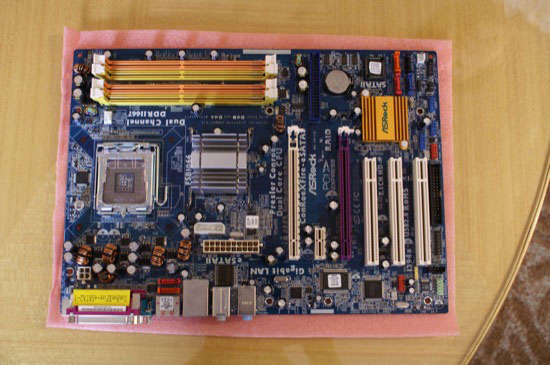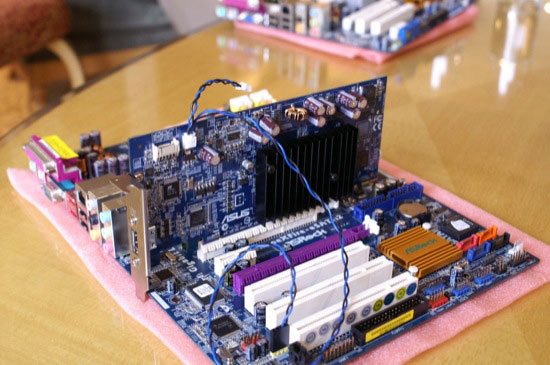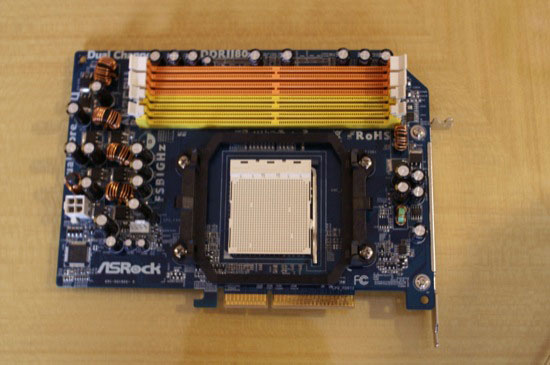Computex 2006: 300W GPUs, Conroe, HDMI Video Cards and Lots of Motherboards
by Anand Lal Shimpi on June 5, 2006 10:24 PM EST- Posted in
- Trade Shows
ASRock
ASUS' low cost spinoff, ASRock, has done quite well since its introduction to the already saturated motherboard market. ASRock's designs continue to be extremely cost effective all while carrying ASUS' usual quality of engineering. First up from ASRock is a Conroe 975X motherboard:

ASRock is working on a Broadwater board for Conroe as well, but in order to avoid competing directly with ASUS the Broadwater solution is being held back for the time being.

The ASRock 975X Conroe solution has an on-board SPDIF header that can be connected to a HDMI equipped video card (an ASUS solution is pictured above) to allow for digital audio passthrough over HDMI.
ASRock also showed us its new nForce 6150 based Socket-AM2 motherboard built in a micro-ATX form factor:

Remember ASRock's upgradable motherboard that allowed you to simply purchase a new CPU card and switch between sockets 754 and 939? ASRock showed us its new Socket-AM2 card for the Upgrade series motherboard:

The AM2 card should be available almost immediately and priced as low as $40 - $50, however ASRock isn't sure if vendors will mark the card up even more due to its relatively low volume.










61 Comments
View All Comments
phusg - Tuesday, June 6, 2006 - link
No, transparent side windows already did that ;-)
OCedHrt - Tuesday, June 6, 2006 - link
So what happened to ASRock boards (supposedly page 18)?bongobear - Tuesday, June 6, 2006 - link
I'd like to see what ASRock have lined up as well, however the mini-ITX Albatron boards that were shown in their place were a nice surprise. If they can tweak those a little and get them out at a nice price, very tempting....JarredWalton - Tuesday, June 6, 2006 - link
Anand has a ton of pictures and information from his trip, so he'll probably provide a second update later. However, I've updated the page links to correctly reflect the Albatron content on page 17.Stele - Tuesday, June 6, 2006 - link
There are actually two major types, one (the more common) being filled with solid compound as noted, and are simply called solid electrolytic, or solid aluminium electrolytic capacitors. The other type uses non-solid electrolyte. Both types are better than the usual electrolytic capacitors of course in terms of resistance to high temperatures - generally around 1,500-3,000 hours at 105°C-125°C. Another useful characteristic is that they perform well in high-frequency, high-capacitance applications, which is one reason they've often been used on graphics cards, for example.
They are however not immune from leaking and other capacitor related failures... it's just that they can survive prolonged exposure to higher temperatures for longer periods of time than the regular electrolytic capacitors before they too fail.
This, unfortunately, is non sequitur i.e. it does not follow. Component choice is but one of so many factors in determining the stability, performance and reliability of a product. A cheapo backyard manufacturer could boast 16-phase power, all-Nichicon/Rubycon solid electrolytic caps, Philips MOSFETs and AMP connectors all around but would still fail if the circuits were designed by a half-baked engineer fresh out of college and poorly manufactured. Of course, it could be used by the said cheapo manufacturer as a gimmick to fleece the gullible consumers (of which unfortunately there are very many) who rocket to seventh heaven on seeing such big names. Or a not-so-cheapo manufacturer could make their product more attractive by using such flash while cutting corners on areas where consumers probably won't notice in perhaps the first 6 months of use.
Speaking of gimmick, as mentioned above these capacitors are more useful in high-frequency, high-temperature applications. Naturally not every single circuit nor square inch of a motherboard would call for them and hence the extra cost of 100% solid electrolytic capacitors is unnecessary - they cost in the order of 3-5 times that of regular electrolytic caps, and when added up the savings could certainly be better used elsewhere on the board. For now, at least, other than the circuitries that really could benefit from the solid electrolytic capacitors, I would agree with the other manufacturers that indiscriminate plastering of the board with them is rather more marketing gimmick than engineering.
Viditor - Tuesday, June 6, 2006 - link
Anand/Jarred...I have a few questions if you get time.1. How is the RAS functionality for Woodcrest with the Asus server board?
2. Do the FBDIMMs require active cooling, and if so how much?
3. When Asus released the A8N32-SLI, they hinted at releasing more boards with the 8 phase power...have/will they?
4. Any chance on finding out what the functionality is for the 1207 pins on Socket F?
Cheers! And thanks for the article...!
bob4432 - Tuesday, June 6, 2006 - link
after all this time and the floppy still lives on ...... ;)Calin - Tuesday, June 6, 2006 - link
Floppy is still the only way to load certain drivers for hard drive controllers in Windows (during installation). And as long as this will be the case, the floppy will live onDigitalFreak - Tuesday, June 6, 2006 - link
Fortunately, this problem goes away with Vista. I'm hoping that in a couple of motherboard revs, those damn things will go away.JarredWalton - Tuesday, June 6, 2006 - link
I linked in higher res images for some of the more interesting photos Anand took. If you would like to see any others in more detail, let me know (via email) and I will see about adding those. Note that some images are left in "lo-def" because it reduces blurriness. :)Take care,
Jarred Walton
Editor
AnandTech.com